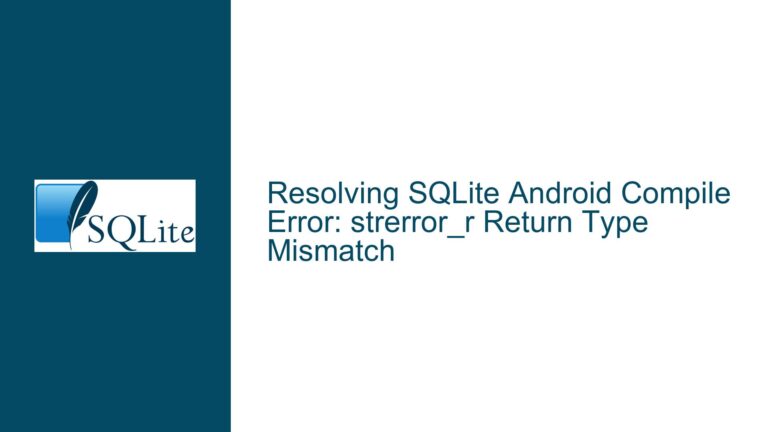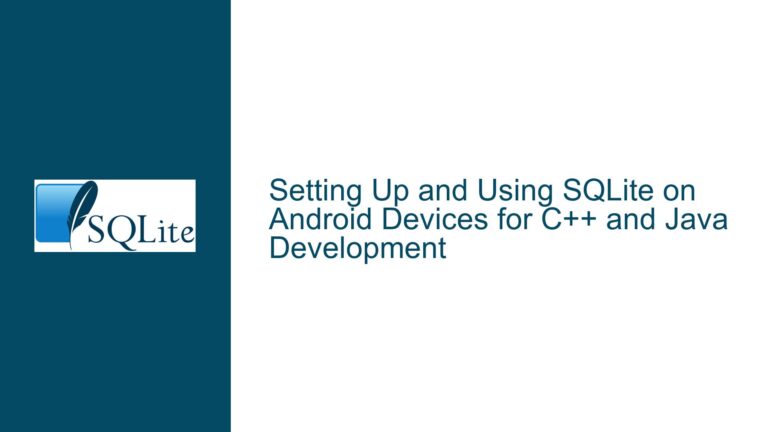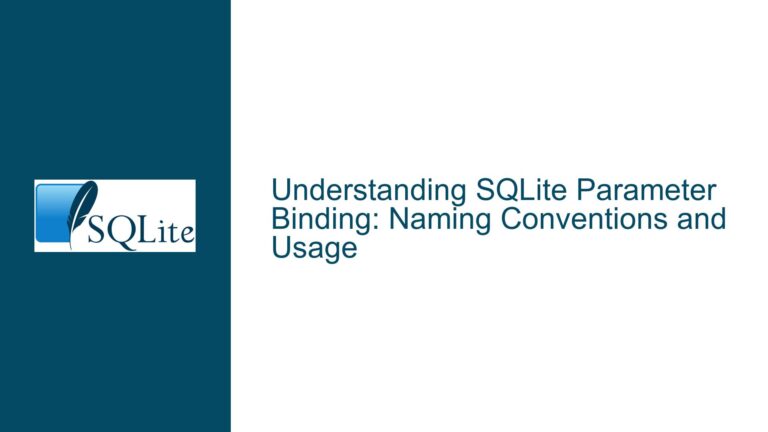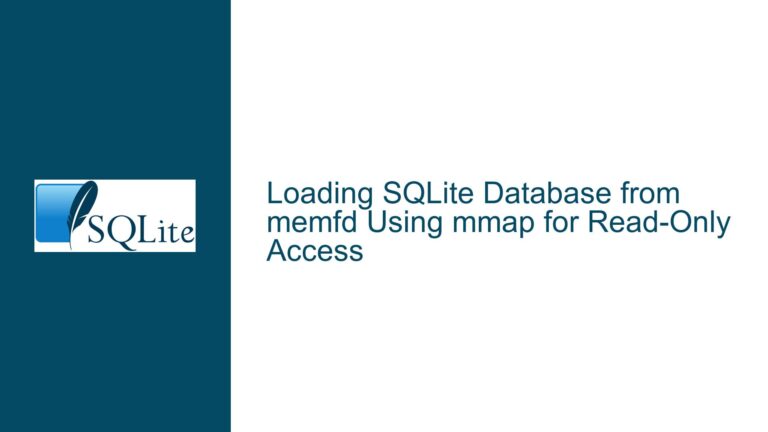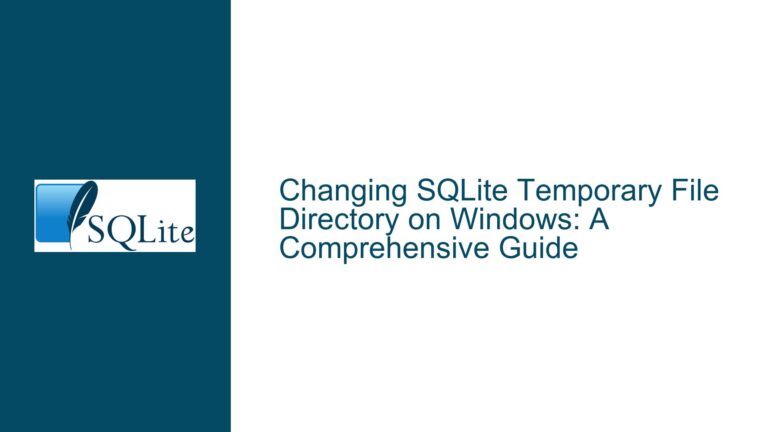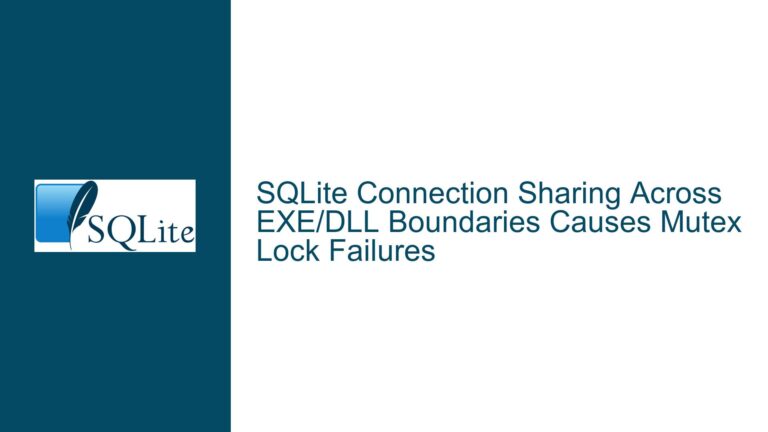Upgrading SQLite Embedded in Third-Party Applications Like Blackmagic Design
Understanding the Challenge of Upgrading SQLite Bundled with Vendor Software
The core issue revolves around upgrading SQLite when it is distributed as part of a third-party application (e.g., Blackmagic Design software) where the database engine is tightly integrated. SQLite is often embedded directly into applications via static linking or placed in proprietary library paths. This creates a dependency chain where the SQLite version is controlled by the vendor, not the end user. The problem arises when security vulnerabilities or compatibility requirements necessitate an upgrade, but the application vendor does not provide a straightforward mechanism to update SQLite independently.
In this scenario, the user attempted to upgrade from SQLite 3.34.0 to 3.37.0 (or newer) but encountered resistance due to the lack of documentation and vendor support. The discussion highlights critical misunderstandings about SQLite versioning, linkage methods, and the risks of forcibly replacing components in vendor-controlled software.
Root Causes of Upgrade Limitations in Vendor-Embedded SQLite
Static Linking and Vendor-Specific Dependency Management
Many commercial applications like Blackmagic Design’s software statically link SQLite into their binaries. Static linking compiles SQLite directly into the application’s executable, making it inseparable from the host program. This design choice ensures stability and reduces external dependencies but eliminates the possibility of user-driven upgrades. Even if a newer SQLite shared library exists on the system, the application will ignore it in favor of its embedded copy.
Lack of Vendor Support for Component Upgrades
Vendors often do not expose upgrade pathways for individual components like SQLite. Their software is tested and certified against specific dependency versions, and altering these can introduce instability. When Blackmagic Design declined to assist, it signaled that their software either does not support modular updates or that they lack documentation for such edge cases.
Misinterpretation of Security Vulnerabilities and Version Requirements
Security scanners frequently flag outdated SQLite versions without contextualizing risk. A vulnerability in SQLite 3.34.0 might not be exploitable in the application’s specific usage context. The user’s focus on upgrading to 3.37.0 (instead of the latest 3.47.0) suggests either a misunderstanding of SQLite’s versioning scheme or reliance on outdated vulnerability reports.
System Library Conflicts and Code-Signing Constraints
For applications that dynamically link SQLite, replacing the shared library might seem feasible. However, macOS and Linux enforce code-signing and library integrity checks. Overwriting or redirecting libraries (e.g., via LD_LIBRARY_PATH or ld.so.conf.d) can break the application’s signature, triggering security warnings or causing runtime failures.
Comprehensive Strategies for Diagnosing, Mitigating, and Resolving Embedded SQLite Issues
Step 1: Confirm SQLite Integration Methodology
Action: Determine whether the vendor application uses static or dynamic linking.
- macOS: Use
otool -L /path/to/application/executable | grep -i sqlite. If no SQLite libraries are listed, static linking is likely. - Linux: Use
ldd /path/to/application/executable | grep -i sqlite. Absence of output implies static linking. - Windows: Tools like Dependency Walker or Process Explorer can identify loaded DLLs.
Outcome: If SQLite is statically linked, proceed to Step 3. If dynamically linked, proceed to Step 2.
Step 2: Attempt Controlled Library Replacement (Dynamic Linking Only)
Action: Replace the SQLite shared library referenced by the application.
- Linux: Overwrite the library in the application’s private
libdirectory (e.g.,/opt/blackmagic/lib/libsqlite3.so.0). Ensure the new library is ABI-compatible with the old version. - macOS: Use
install_name_toolto redirect the library path to a custom location. This requires disabling SIP (System Integrity Protection) and will invalidate code signatures. - Windows: Replace the DLL in the application’s installation directory.
Risks:
- Breaking ABI compatibility may crash the application.
- Code-signing failures may prevent the application from launching.
- Vendor updates may overwrite your changes.
Recommendation: Test replacements in a sandbox environment first.
Step 3: Engage the Vendor with Technical Evidence
Action: Escalate the issue to Blackmagic Design’s support team with technical details:
- Provide CVE numbers for SQLite vulnerabilities affecting 3.34.0.
- Request a timeline for certified updates to SQLite 3.47.0+.
- Inquire about enterprise or developer editions that allow component upgrades.
Fallback: If the vendor is unresponsive, consider:
- Submitting a feature request through their public forum.
- Leveraging customer support channels for security compliance (e.g., SOC2, ISO 27001).
Step 4: Evaluate Security Risks Realistically
Action: Perform a threat model analysis to assess exploitability.
- Example: CVE-2022-35737 (SQLite 3.39.2) involves a buffer overflow in the
printffunction. If the application does not usesqlite3_str_vappendf, the risk is negligible. - Use tools like
strace(Linux) ordtrace(macOS) to monitor SQLite function calls and identify exposure points.
Outcome: If the vulnerabilities are not exploitable in the current deployment, defer the upgrade until vendor support improves.
Step 5: Isolate the Application in a Security-Controlled Environment
Action: Mitigate risk by restricting the application’s network and filesystem access.
- macOS: Use
sandbox-execto create a custom profile that blocks unauthorized SQLite operations. - Linux: Implement SELinux/AppArmor policies to confine the application.
- Windows: Use Windows Defender Application Control (WDAC).
Benefit: Reduces the attack surface without modifying the application.
Step 6: Explore Alternatives to Forced Upgrades
Option A: Use a separate SQLite instance for custom workflows.
- Install the latest SQLite version system-wide and route application-external database operations to this instance.
Option B: Interpose a shim library.
- Develop a shared library that overrides critical SQLite functions (e.g.,
sqlite3_open_v2) to redirect queries to a modern SQLite build. Requires advanced knowledge of LD_PRELOAD (Linux) or DYLD_INSERT_LIBRARIES (macOS).
Option C: Virtualization/Containerization.
- Run the vendor application in a Docker container with a controlled SQLite version. This is viable only if the application supports containerized environments.
Step 7: Monitor for Vendor Updates and Community Solutions
Action: Subscribe to vendor newsletters, GitHub repositories, and SQLite mailing lists.
- Automation: Set up a Canary token to alert when the application’s
libsqlite3dependency changes. - Community: Check forums like Stack Overflow or specialized groups for workarounds specific to Blackmagic Design software.
Step 8: Prepare for Long-Term Contingencies
Action: If the vendor never updates SQLite and risks become unacceptable:
- Migrate to alternative software that uses updatable SQLite.
- Petition the vendor to open-source components reliant on SQLite, allowing community patches.
Final Notes
Forced upgrades of embedded SQLite are inherently risky and rarely successful without vendor cooperation. The optimal path combines rigorous risk assessment, controlled environment isolation, and persistent vendor engagement. Where technical constraints prevent upgrades, compensating security controls and architectural workarounds can mitigate exposure until a sanctioned update becomes available.

